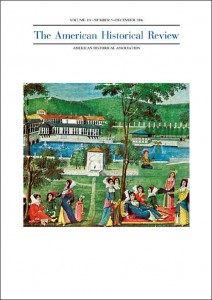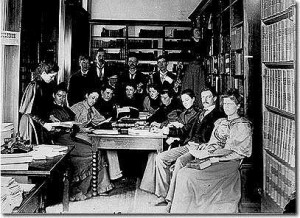Edmund Fisk Green (better known as John Fiske) was educated at Harvard and is a key “transitional” historian as he is sometimes compared with Bancroft as well as the scientific historians we will look at shortly. Though a believer in American progress (that he coined as “progressiveness”) Fiske rejected the Calvinism of Bancroft and instead was a disciple of famed English “scientific historian” Edward A. Freeman. Bancroft and Fiske would both agree on the dominance of the White Anglo-Saxon Protestant race, they would, however, differ in the how’s and why’s.
Fiske believed in a theory of evolution that could be applied to American civilization (and the world for that matter) but his views and ideas were deemed “unconventional” and never reached the level of popularity that Bancroft had enjoyed. Since his days at Harvard (1860) Fiske was also a follower of Herbert Spence and Social Darwinism. In his book The Destiny of Man Viewed in the Light of his Origin, Fiske devoted a whole chapter to “Mr. Darwin.” His views on evolution dominated his writing at times and probably helped to produce his most original history, The Discovery of America (1892) where in it he discussed the “evolution of primitive society” in relation to Native Americans and not just Europeans. Fiske was one of the first historians to stress the important role that archaeology can play in the study of early American history.
Fiske never reached the level of scientific methodology that would place him in the professional level of historian as he too often relied on secondary sources and was never a great editor. Fiske also didn’t fit into Bancroft’s school of thought, though he held strong religious beliefs; however, he was never comfortable with Bancroft’s historical theology. As one modern historian noted, “To the end of his days Fiske was still trying to harmonize his religious beliefs and ideals with the latest doctrines of science.”

America’s first Historical Association (AHA) was founded in 1884 and its first important professional publication, the “American Historical Review,” appeared in1895. The writing of American history was changing hands from pseudo-professionals to what we would call modern scholars. The Bancroft’s and Fiske’s, though stylists and scholars in their own right, never reached the level of inquiry that the scientific and professional class did.
David Hackett Fischer in his “Historical Fallacies” wrote that each generation would have to assimilate nearly twice as many books as the proceeding generation. By the turn of the century something was happening within the American historical profession. First, it was becoming a true “profession” where scholars went to the University to study history; second, its membership was increasing exponentially and; third, the amount of scholarship produced alone demanded a change in methodology.
Prior to the 1880s the evolution of archives and collections was uneven and dispersed, and the writing of American History rested in the hands of the few. However, by the early 1900s everything had changed. In 1903, the first “Writings on American History” appeared with its bibliographical listing of published works organized into categories. The editors wrote a short introduction and in it they stated:
The writings on American history are now so numerous, so many valuable articles appear in unexpected places, so many papers are published in the proceedings of historical societies under such circumstances that they may not normally attract the attention of even the watchful specialist, so many in fact are the difficulties in the way of keeping abreast of American historical bibliography, that a list of this kind would seem to have its evident usefulness. Only by some such means as this can we avoid, as the years go by, the most baffling confusion or prevent the practical disappearance of even some important contributions.
The eventual founder and editor of the American Historical Review John Franklin Jameson noted in 1891 the growing differences between old and new scholarship in the historical profession. Before the 1890s historians worked in “isolation” and often with limited materials. He summarized his findings noting two important changes:
In the domain of American history, the change has taken effect in two directions or modes. In the first place, we have become more critical and discriminating, have learned more nearly to look upon the course of American history with an impartial eye, from the standpoint of an outsider. In the second place, there has ensued a broadening of the field of investigation and work, that its scope may correspond to the scheme of things in America, to the configuration of actual affairs.
The dawn of professionalism had been reached. This “first generation” of professional scholars evolved from 1870 to 1910, according to one historian. The idea of “progress” is still present in the works of historians such as Frederick Jackson Turner and his “Frontier Hypothesis,” but the idea of progress and American civilization is less important to these new “objective” scholars who wanted scientific analysis of historical data. Jackson was closer in philosophy to Bancroft than to the new movement though he would cross over from time to time as exemplified in his 1891 essay “The Significance of History.” Therefore, probably the best representative of the “scientific” school of history was Henry Adams. 
Part III coming tomorrow
[Footnotes removed so as not to allow someone to use this paper.]